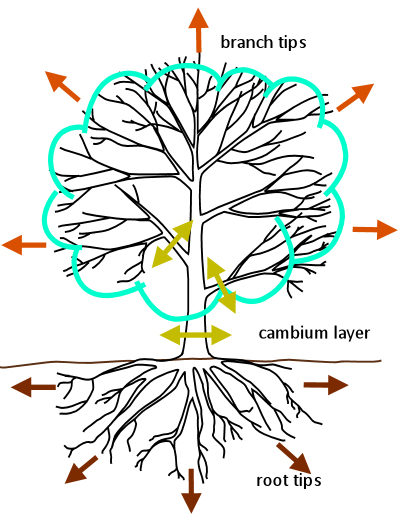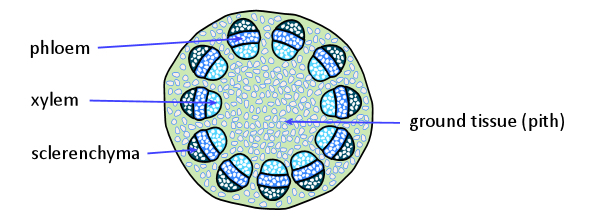Growth processes

Trees grow in three directions:
Upwards (and outwards in branch length). The tree grows in height and width as its shoots build new cells onto the growing tips to make the branchlets longer.
Downwards (and outwards in root length). The root tips grow as they search for water and nutrients in the soil. Absorption occurs mostly in the root hairs, which start just behind the tips.
Outwards (in branch, trunk and root thickness). The cambium layer makes the tree grow in girth. On the phloem side in the stem, it forms new inner bark, and on the sapwood side it forms new wood tissue.
Primary growth and secondary growth
One of the fundamental differences between animal cells and plant cells is that animal cells don’t have a rigid wall around them, whereas plant cells do.
In this sense, you could say that ‘all plant cells live in a wooden box’, since the cell’s contents are surrounded by a fibrous wall made up mostly of cellulose strands.

Primary growth
Primary growth occurs when the shoots and roots increase in length as the cells divide and multiply.
Most primary growth occurs at the tips of these parts, which allows the shoots to continue growing towards sunlight and the roots to seek out water.
The phloem tissue is made up mainly of tube-like cells, joined end-to-end to allow the tree’s food supply to flow through. The xylem tissue also has cells that join up like drinking straws, although the purpose of these cells is to transport water from the roots to the leaves.
The sclerenchyma cells have thickened walls which contain lignin, giving the cells extra strength. Their purpose is to provide structural support to the vascular bundles – which comprise discrete bundles of phloem, xylem and sclerenchyma cells.

Secondary growth
Secondary growth takes place in particular cells when the walls thicken on the inside. It occurs in the cambium layer, which results in an increase in the thickness of the plant’s stem, branches and roots.
During secondary growth, the network of cellulose strands is filled in with hemicelluloses, which provide additional support, and lignin, which acts like a binder. This lignified wood tissue forms the structural fibres that are characteristic of all ‘woody’ plants, including trees, shrubs and some vines.

Difference between woody plants and herbaceous plants

Herbaceous plants generally only have primary growth in their stems, which makes them much more flexible than those of woody plants.
The stems and leaves tend to die down to soil level at the end of every growth season.
Annual herbaceous plants die off completely every year, and then re-generate from seed in the following year.
Most garden vegetables are annual herbaceous plants. So too are the garden bed flowers that are simply referred to as ‘annuals’.
Perennial herbaceous plants still die off above ground every year, but the roots and other underground parts survive, enabling the plants to grow back year after year. Asparagus and rhubarb are both perennial vegetables.
By contrast, plants that have woody fibres in their structure don’t die off at the end of each season, but continue to build new layers of wood tissue into their stems every year, increasing the diameter of the stem. This seasonal growth often appears as growth rings in the stem.